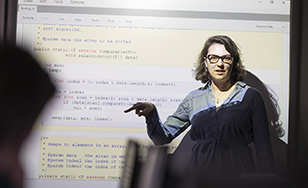December 7, 2018
National leadership

St. Scholastica has created the National Center for Computer Science Education, which helps create equitable computer science education opportunities for all K-16 students and educators.
In addition, St. Scholastica has been awarded a $608,000 grant by the National Science Foundation to study how to broaden participation in high school-to-college pathways in computer science. In particular, the three-year initiative will research the implementation and outcomes of Concurrent Enrollment programs, which allow high school students to take college or university courses.
The National Center for Computer Science Education is directed by Jennifer Rosato, one of the nation’s leading authorities on effective computer science learning for K-16 students, particularly those who are traditionally underrepresented and underserved in the field. Rosato is an assistant professor of Computer Information Systems at St. Scholastica; the Center is a partnership of St. Scholastica’s Computer Information Systems department and the School of Education.
Computer science (CS) is defined as the study of computers and algorithmic processes, including their principles, their hardware and software designs, their implementation, and their impact on society.
“CS is a pervasive fact of our society now and in the future,” Rosato said. The Center “will focus on directly impacting teachers and schools through providing the curriculum and professional development that enables them to integrate computer science into their schools, or to teach CS in their schools. We also want to provide teachers with research evidence for best practices in how to teach computer science. And we evangelize to policymakers on behalf of CS for all students in all schools.”
The National Center for Computer Science Education “serves as a national leader for education and research at a critical time when there is significant momentum through the CSforALL movement,” said Rosato. “St. Scholastica is one of fewer than 10 schools in the country that have both pre- and in-service teacher education in computer science and is considered an expert in online computer science professional development.”
CSforALL is an initiative to empower all K-12 students to learn computer science and be equipped with the computational thinking skills they need to be creators in the digital economy, not just consumers, and to be active citizens in a technology-driven world.
Rosato was honored as a “commitment maker” at the CSforALL summit in Detroit, MI, in October. The CSforALL Summit is an annual gathering of more than 400 stakeholders including educators, school districts, and representatives from government, industry, higher education, and the nonprofit sector.
“Equitable participation means that all students have access to high quality opportunities in computer science,” Rosato said. “This includes students typically underrepresented in computer science: females, African Americans, Hispanics, Native Americans, English learners, and students with disabilities. It also means that early exposure to CS experiences is integrated as a part of the required curriculum for all students and not just an optional class or afterschool activity. For those students who want to explore CS in more depth, having additional courses available at the secondary level that are open to all students is essential. Understanding computing and its impacts on our society is a foundational skill for students and teachers to succeed in the 21st century. Our programs help prepare educators to teach all students computer science.”
The $608,000 National Science Foundation grant, meanwhile, supports the establishment of a Concurrent Enrollment pathway called Mobile Computer Science Principles, which Rosato said is “a ‘breadth-first’ introduction to computer science specifically designed to be engaging for underrepresented high school students – minorities, women, students who historically would not have considered computer science as something for them.”
A Concurrent Enrollment pathway is distinct from an Advanced Placement pathway, Rosato noted.
“Advanced Placement is a high-stakes testing environment, which not all students do well in. It also has only one test date per year across the country, so it doesn’t fit with some schools’ schedules very well. With Concurrent Enrollment, you can have the entire academic calendar year to work on the course. It is the student’s grade over time, all of their assignments, all of their exams, not just a single high-stakes exam.”
The curriculum Rosato and colleagues designed is called “Mobile” Computer Science Principles because “our curriculum takes the philosophy that students are more engaged and interested in computer science when they’re building something useful to them. And students find apps useful and interesting and fun, so we use app-building to create socially useful apps for themselves and their communities.”
The Mobile Computer Science Principles program at St. Scholastica has formed a Researcher-Practitioner Partnership with Capital Community College in Hartford, CT, and Southwest Minnesota State University in Marshall, MN and with partner school districts in each state. This project will provide professional development and support for 40 high school teachers to teach the Mobile CSP course among partnering school districts over the course of three years.
The Mobile CSP project at St. Scholastica also has partnered with the National Math and Science Initiative and other research-based programs to pilot K-12 pathways in computer science.
Through the efforts of Rosato and the National Center for Computer Science Education, Minnesota has been selected to join the Expanding Computing Education Pathways (ECEP) Alliance. ECEP aims to increase the number and diversity of students in K-16 computing pathways, and works to achieve this goal through education policy reform. More information about these efforts in Minnesota can be found at csforallmn.org.
In addition to directing the National Center for Computer Science Education, Rosato is serving this academic year as the incoming chair of the Computer Science Teachers Association. Starting in July 2019, she will serve as the international organization’s board chair for two years. In these roles she serves as a champion for effective preparation of computer science teachers, and convenes stakeholders to further best practices within the field of teaching computer science.

